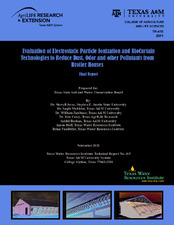| dc.description.abstract | Confined poultry production has increased in Texas and along with it, complaints of odor and
dust. These issues are a major problem in the United States not only for confined animal health
but also for the increasing urban migration to the rural areas where the poultry industry is expanding. Particulate matter and volatile organic compound (VOC) produced in the poultry
houses can be offensive to neighbors, and if not properly vented, pose a serious health hazard to
the animals. Some technologies available attempt to strike a balance between reducing poultry house emissions and maintaining bird health; however there is a lack of sufficient pollutant-
reduction data to make a sound fiscal judgment in
the implementation of this equipment. Two
possible management tools that have shown promise and were chosen for evaluation during this
project were an Electrostatic
Particle Ionization (EPI™)
system and a BioCurtain™.
The EPI™ system includes an antenna-like array of wire strung through the poultry house with a small electric charge running through it. The resulting electric field ionizes the particulate matter suspended in the air, causing it to attract to grounded materials.
The BioCurtain™ consists of a black geotextile fabric stretched over a quadrant-shaped, metal
frame skeleton, and placed over the exhaust fans of the poultry houses. Air moving out of the house flows down along the top of the quadrant and particulate matter settles out on the ground.
The air, without the particulate matter, then
flows vertically out
through the top of the
BioCurtain™.
This project tested the effectiveness of a BioCurtain™ and Electrostatic Particle Ionization (EPI™) system in reducing NH3, H2S, and TSP emissions from a broiler house during short periods in September and December 2010. This project found:
1) A reduction of about 9%, in the emission of NH3 and H2S gases (1060 vs. 960 g/hr for
NH3 and 9.3 vs. 8.5 g/hr. for H2S) in December when only the BioCurtain™ was active.
2) The BioCurtain™ resulted in a 34% (325 vs. 213 g/hr. in September) to 43% (396 vs.
227 g/hr in December) reduction in the TSP emission.
3) The EPI™ system reduced the NH3 and TSP emission rates by as much as 17% and 39%, respectively. | en |


